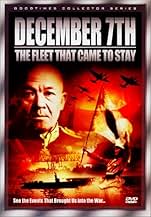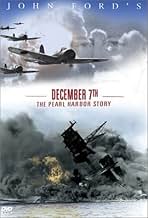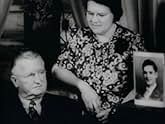"Docudrama" about the bombing of Pearl Harbor on December 7th, 1941 and its results, the recovering of the ships, the improving of defense in Hawaii and the US efforts to beat back the Japan... Read all"Docudrama" about the bombing of Pearl Harbor on December 7th, 1941 and its results, the recovering of the ships, the improving of defense in Hawaii and the US efforts to beat back the Japanese reinforcements."Docudrama" about the bombing of Pearl Harbor on December 7th, 1941 and its results, the recovering of the ships, the improving of defense in Hawaii and the US efforts to beat back the Japanese reinforcements.
- Won 1 Oscar
- 1 win total
- Narrator
- (voice)
- (as James K. McGuiness)
- Shinto Priest
- (uncredited)
- Self
- (uncredited)
- Reporter
- (uncredited)
- Wounded Officer
- (uncredited)
- Self
- (archive footage)
- (uncredited)
- Self
- (uncredited)
- Self
- (uncredited)
- Self
- (uncredited)
- Self
- (uncredited)
- Hawaiian Boy
- (uncredited)
- Pvt. Joseph L. Lockhart
- (uncredited)
- Directors
- Writer
- All cast & crew
- Production, box office & more at IMDbPro
Storyline
Did you know
- TriviaTurner Classic Movies showed the original uncut "censured" version of this movie on 15 September 2015. During the introduction with Ben Mankiewicz and Mark Harris, one of many reasons why the movie was censored was in 1943 it was considered too racist against the Japanese.
- GoofsShowing the events of the Sunday morning attack, the priest at Mass (at Kaneohe, I believe) announces incorrectly that it is the 1st Sunday of Advent. Actually it was the 2nd Sunday of Advent.
- Quotes
World War I Ghost Soldier: Six will get you twelve that fifteen to twenty years from now they'll be opening up new sectors in here.
- Crazy creditsThe War and Navy Departments, producers of the movie, are credited orally by a narrator.
- Alternate versionsSpecial 50th anniversary edition on video released in 1991 is restored to 82-minute length with subtitles added to Japanese language sequences and a descriptive prologue added. The 1943 version was a completely censored 34-minute version with the full version being banned by the US government for being damaging to morale.
- ConnectionsEdited into Task Force (1949)
- SoundtracksColumbia, the Gem of the Ocean
Written by David T. Shaw
Arranged by Thomas A. Beckett
Played as background music often
You have to get the full 82-minute version. The first 15 minutes are blatantly racist and jingoistic. Walter Huston plays the embodiment of Uncle Sam, which is pacifist, as America was in 1941, despite the war in Europe. Harry Davenport plays Mr. C, Uncle Sam's conscience. The two begin a dialogue where, despite Uncle Sam's best efforts to portray Japanese-Americans as loyal, Mr. C picks apart the defense and sells our own citizens are being ripe for recruitment by the Imperial Japanese military. It's done so covertly as to leave the impression that any Japanese-American could be a spy. It even uses Korean actor Philip Ahn as a smiling Shinto priest to malign that religion and say that any religion other than Christianity is immoral.
Amazingly, Nazi spies show up to "aid" the Japanese spies, who are always smiling. Toland shows Nazi spies listening to the conversations of sailors and civilians who spill military secrets like slippery glasses of milk. Oddly enough, the scenes of Americans freely spilling secrets and Nazis spies walking around Hawaii pretty as they pleased should have been more of a security concern than Japanese-Americans who taught their kids about their ancestry and culture.
The action shifts (finally) to December 7th. The radar scene is featured prominently, then the Japanese planes attack. I have to say that Toland may have thought his special effects were something in 1943, but now they look just plain cheesy. Paper-mache ships explode in showers of sparks, instead of flames. You can clearly see the strings holding up the Japanese planes. Despite being riddled by .30- and .50-caliber bullets from the Japanese planes, American sailors take the time to stop, drop and die gracefully.
What's most galling is the inaccuracies. Toland shows the battleship Nevada underway (which really happened), but then shows Japanese torpedoes blowing her into a mass of flaming wreckage. In reality, about 25 Japanese bombs wrecked her decks as the Nipponese pilots desperately tried to sink her to bottle up the entrance to Pearl Harbor.
Also, the movie shows mock-ups of the battleship Pennsylvania, as well as the destroyers Cassin and Downes. All three are in dry dock. Suddenly, a slew of bombs rips the Pennsylvania apart. The destroyers follow suit. In reality, a crane operator used his crane boom to thwart attacks on the Pennsylvania and she suffered one superficial bomb hit. The missed bombs, however, did pummel Cassin and Downes in junk that boxed the battleship in for weeks.
Also, the narrator "cleverly" points out that the Japanese pilots calmly fly across Hawaii, confident that their attack is a complete surprise, but they many hundreds of Japanese-Americans-turned-spies have lulled America to sleep. The pilots know they are about to deal a blow to the ships that lay at anchor because they have been specifically targetting those same ships in practice. Also, the two Japanese ambassadors in Washington talking to Henry Hull, are called sneaky and bland, knowing the attack is imminent.
In truth, the attacking pilots were afraid that they would be met by American fighters and anti-aircraft fire all the way in. When they broke into the skies above the anchorage with no American the wiser, only then did squadron leaders issue the code word that meant they had achieved complete surprise. The pilots had been after the American carriers all along, not the battleships, but only learned the carriers were not in port just a short time before take-off. Fuel concerns and fears of American submarines prompted them to launch the attack rather than wait a day or so to see if the carriers appeared. Finally, the Japanese ambassadors in Washington had no idea an attack was to occur. Japanese prime minister Hideki Tojo had sent them a confusing message that made no hint of war. Tojo knew the ambassadors were fond of America and didn't want them giving out any warnings.
The movie shows the three Japanese midget submarines that were captured after the attack and says they were all captured. In reality, three were captured, but two were sunk, along with the mother submarine that had carried them all. Curiously, one sub was sunk as it entered the harbor prior to the attack, but the report somehow never made it to the right people. That was a more glaring error than the radar foul-up, but some poor Army Air Force lieutenant incurs Toland's wrath rather than the captains and admirals who screwed up the submarine report.
Also, the narrator (George O'Brien) triumphantly remarks that 200 Japanese planes attacked and 50 were shot down. The movie shows the second wave of Japanese planes being shredded and driven off by our brave gunners. In truth, only 29 planes and 55 Japanese fligth crewmen were lost (along with 25 guys on the submarines, including the ones on the captured midget subs who committed suicide). Here were have America's first instance of enemy casualty rates.
The film ends with the narrator pointing out some of the sailors and Marines who died. Toland and Ford are smart enough to include all races -- black, white and Hispanic. The parents of the deceased potrayed themselves. The movie ends with a patriotic speech between the narrator and the ghost of an American sailor, played by Dana Andrews. I'm as patriotic as the next guy, but I was ready to puke by this point.
Back in 1942 when this film was first shot, the inaccuracies and racism were overlooked because they got Americans' blood boiling. After the war when the facts of Pearl Harbor slowly came out, the film looked more and more fake, ultimately becoming as much a novelty as those stupid government education films of the 50's and 60's that warned of Communists around every corner and of marijuana destroying the country.
All in all, December the 7th is worth a look just to see how America portrayed itself and its enemies during the war. The Japanese did the same thing with a film called "I Bombed Pearl Harbor," which was a hit in Japan until the Imperial Navy went down in flames at Midway.
If you want to know what really happened at Pearl Harbor, buy the war classic "Tora, Tora, Tora."
Details
- Runtime1 hour 22 minutes
- Color
- Sound mix
- Aspect ratio
- 1.37 : 1
Contribute to this page































